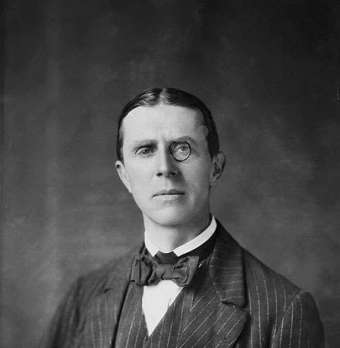(Sir) Leslie Patrick Abercrombie
- Born : 6 June 1879, Ashton on Mersey
- Married : 5 August 1908 Emily Maud (1886–1942), daughter of Robert Gordon
- Died: 23 March 1957
- Burial: St Gwenfaen's church, Rhoscolyn, Anglesey.
Leslie Patrick Abercrombie was born on 6 June 1879 at Green Bank, Ashton-on-Mersey, one of nine children. His father, William Abercrombie (1838–1908), born in Bradford, was a Manchester stockbroker and businessman, with literary and artistic interests, a noted patron and collector of William Morris and Dante Gabriel Rossetti, and an enthusiast for Arts and Crafts wood engraving; his mother, Sarah Ann Heron (1842–1916), was from Dewsbury. Included among his siblings was the poet Lascelles Abercrombie (1881–1938).
In 1887 the family moved to a new home “Lynngarth,” built in Brooklands Road, Sale. It was designed by a Leicester architect, Joseph Goddard, and decorated with the advice of J. Aldam Heaton, who frequently worked with Richard Norman Shaw. The arts and crafts interiors were to leave a strong impression on the young Patrick Abercrombie. Abercrombie was educated at Locker's Park preparatory school, Hemel Hempstead, Hertfordshire (1891–3), before attending Uppingham School, Leicestershire (1893–6), and the Realschule, Lucerne, Switzerland (1896–7).
On 11 May 1897 Abercrombie was articled to the Manchester architect, Charles Henry Heathcote, for four years, at a premium of £300; at the same time attending evening classes at Manchester School of Art. On completion of his articles he worked for three years in the Liverpool office of Sir Arnold Thornely. His Liverpool post prompted his move to Birkenhead, on the Wirral, which he described as ‘a complete break, possibly the most complete in my life’ (Abercrombie, pt I, chap. 2, 1). The area remained his home until 1936. In 1906 he worked for the Chester architect Philip Lockwood for a year, but was disappointed in his hopes of a partnership. However, the historic walled town—then under transformation by the Grosvenors, the major landholders—left a lasting impression upon him. In 1907 C. H. Reilly, head of the Liverpool University school of architecture, offered him an appointment as junior lecturer and studio instructor. This proved a defining moment in Abercrombie's career, and began his long involvement with civic design and town planning.
His planning career began in 1914 when he won an important planning competition for Dublin. The following year he took over from Stanley Davenport Adshead as Lever Professor of Civic Design at the University of Liverpool. He rapidly became a leading authority on national UK planning matters and garden-city initiatives. Influenced by Geddes and the cultured Liberal tradition of his time he was opposed to state intervention. He went on to be Lecturer at Liverpool; Professor of Civic Design; Editor of Town Planning Review; President of the Town Planning Institute; Member of Council RIBA; Professor of Town Planning, University of London. While a professor of town planning at University College in London (1935–46), Abercrombie devised post-war reconstruction plans for London and its environs. With the County of London Plan (1943; co-authored by John Henry Forshaw) and the Greater London Plan (1944), he sought to combat urban sprawl by resettling the population into a number of distinct, self-sufficient communities connected by an improved network of roads. He also contributed to the redevelopment of other war-torn English towns, including Plymouth, Hull, and Bournemouth, and cities outside England like Edinburgh, Hong Kong, and Addis Ababa, Ethiopia. Abercrombie was knighted in 1945.
Sir Leslie Patrick Abercrombie died suddenly at his home in Aston Tirrald, Berkshire. A memorial service was held at St. Martin-in-the-Fields in May 1957 with a speech given by Clough Williams-Ellis.
Address
1914-1922: Liberty Buildings, School Lane, Liverpool
1935 : London
Residence
1879 : Green Bank, Sale, Cheshire
1879 : The Manor House, Ashton-on-Mersey
1887-1900 : Lynngarth, Brooklands Road, Brooklands (demolished)
1915-1935 : 18 Village Road, Oxton, Wirrall
1957 : The Red House, Aston Tirrald, Berkshire
1930 : Borth Arian (Silver Bay). Rhoscolyn, Anglesey.
Obituary : Manchester Guardian 25 March 1957 page 2
Reference The Architects’ Journal 11 June 1936 page 908-909
Reference Dictionary of Scottish Architects
Reference Mervyn Miller, Oxford Dictionary of National Biography
Reference Who was Who
Buildings and Designs
| Building Name | District | Town/City | County | Country |
|---|---|---|---|---|
| Pair of Cottages at Mouldsworth, near Chester | Mouldsworth | Cheshire | England | |
| Proposed Concrete Houses Rochdale | Rochdale | GMCA | England | |
| Borth Arian (Silver Bay) Anglesey | Rhoscolyn | Anglesey | Wales |
